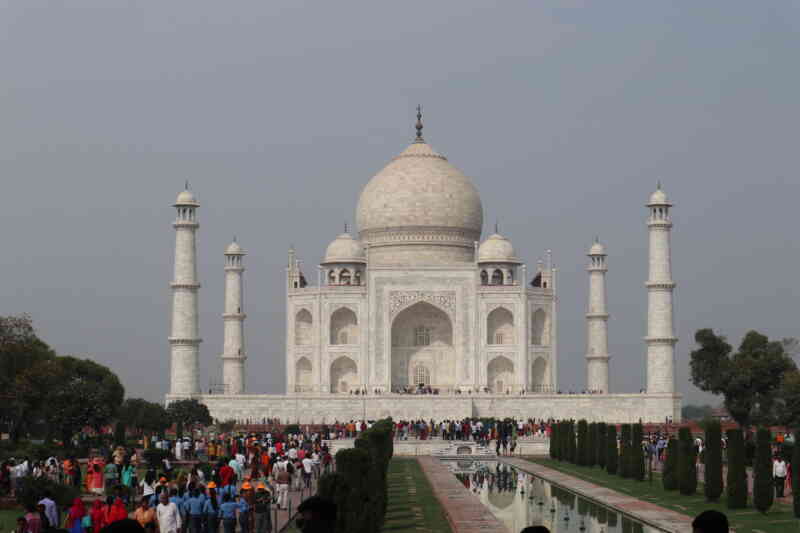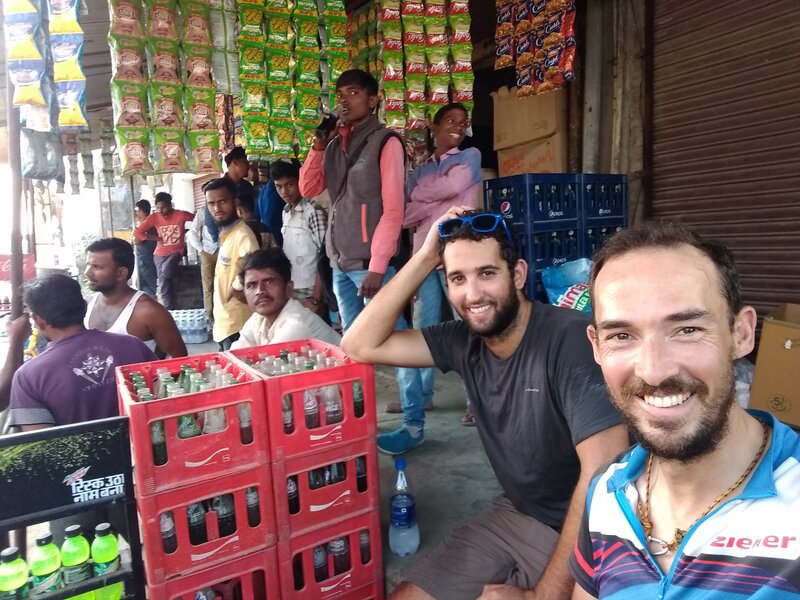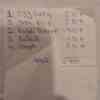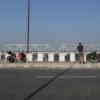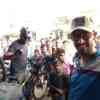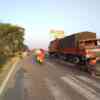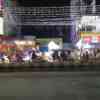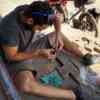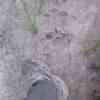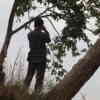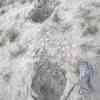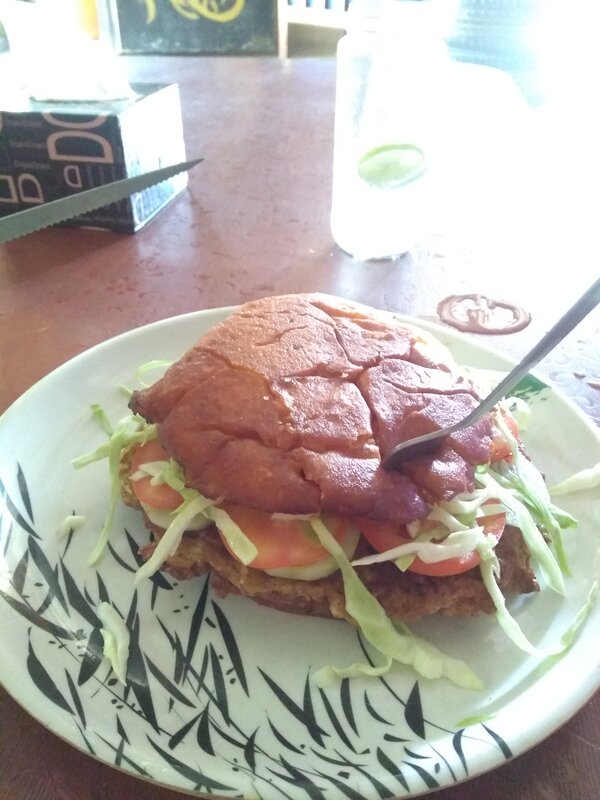Josh and I meet up in Delhi in the early morning. The air pollution has been rampant in the last couple of days, prompting the Delhi government to close schools and restrict traffic. Only half of the private cars are allowed to drive now. Either way we’re both really eager to get out of here quickly.
Undecided which direction to take, we flip a coin: directly to Nepal, or floating down the Ganges? 2 seconds later our destiny is settled: we will head for Nepal… with a small detour.
It only takes a quick 1 or 2 hours to get out of the Delhi metropolitan area and after 2 days of riding we arrive in Aligarh where we will stop over at the “Maharaja hotel” for 2 nights.
Why?
The Taj Mahal is only a few hours bus ride away, and so we head to Agra the next day.
A visit to Taj Mahal
To say it straight away: I didn’t like it.
The story is told quickly: the ticketing process is absolutely horrendous, with separate lines for
- Domestic visitors
- Foreign visitors (which pay different entrance fees based on their nationalities)
- Men
- Women
- Cash payment
- Credit card payments
Mixed up in the hell of the queuing nightmare, some guys with “badges” posing as “tourist guides” and Whatnot, suggesting to change your queue for the “express” treatment, adding only 500 rupees more to the already high entrance fee of 1100 rupees (14 EUR).
Despite only 6 or so people ahead of us we spend about 1 hour in the queue, because the 120 entry tokens for a larger group have to be manually programmed by the cashier, who is serving 2 queues at once.
In short: an absolute bullshit process and a ridiculous waste of everybody’s time.
Dangerous item detected!
Entering the site, it doesn’t get much better: a full-body scan, pat-down and bag check are mandatory.
Ahead of me, an English tourist is asked to open his bags. Inside: a drone.
- “Haha, did you really think they would allow you to bring that inside here?” I laugh out loud
Now it’s my turn.
- “Please open the bag” the security officer tells me
Hmmh. I wonder What dangerous item I have forgotten to take out.
- “Bring this to deposit”, the officer says. She is pointing at a book I’ve brought along for reading on the bus
- “Are you serious? It’s just a book”
She is. She skims the pages. No hidden knifes or guns inside. Just a regular book. But it isn’t allowed anyways. Why? It's not meant for me to find out.
Now the English tourist is laughing at me.
- “1984!” he exclaims, quoting the title of the book. "Are you German?"
- “Uuuuh… yes!?”
- “No wonder… you guys brought communism to the world!”
Okay, I now I get it. This is a crazy place. Nothing here makes sense, not even the visitors.
I give in and leave the dangerous book at the luggage deposit and join the crowd of people who are all taking the same photos. Here are mine:
That visit to the Taj Mahal? A nice reminder why I do not like to do major tourist attractions. And if you’ve been to Turkey, Iran or Uzbekistan before, the mosque itself won’t strike you as a must-see anyways. I’m glad to move on.
Attention, please
The further we venture into the rural Indian North, the more curious people get. Not too many cycle tourists have chosen the path we’re on, it seems. And whenever we stop somewhere for a snack or a drink, a curious crowd forms, staring at us, silently.
It seems that in this region, people either don’t speak English anymore or are too shy to address us foreigners. But whenever someone starts talking to us, the crowd gets close immediately and everybody seems to listen with excitement.
One night we camp on an open field, well aware we would be spotted in the morning. With sunrise, people start walking by, and 30 minutes later a crowd of 20 or more people has gathered on the sugar cane field where we have spent the night, curiously but at the same time respectfully watching us pack up our stuff.
Needless to say that everybody wants a selfie so when we are ready to leave we spend a few minutes taking photos and videos with different phones.
Entering Nepal at Bhimdatta
Coming to Nepal, I am suffering from traveler’s diarrhea once more from some spicy lunch I’ve enjoyed 1 or 2 days before. Thankfully, the staff on either side of the border let me use their restrooms and the emergency is averted.
The border is quite busy, but as seemingly neither Nepalese nor Indian travelers need to go through any kind of immigration procedures, Josh and I almost run past the immmigration checkpoints. The visa fee to enter Nepal for 30 days is 50$, to be paid in cash.
Annoyingly, one my $100 bill is rejected once more: there is a tiny blue ink stain on the back. Already in Iran, some of the rules on acceptance of foreign currency, e.g. $$ no older than X years, had been irritating but this one takes the cake!
Nevertheless, I manage to pay with a different bill and the immigration officer even offers us to change our Indian rupees into Nepalese one’s -- at above the market rate. What a nice surprise.
Also there is less honking. Less of everything. Except for the prices: Things seem slightly more expensive here, even more so since many products are imported from India and come with an according markup. The people on the other hand aren’t better off and very much like in Tajikistan seem to live self-sufficient off their own farming or from the small street-side shops selling eggs, bananas or drinks.
Josh is keen to catch up with the group ahead of us and we decide to part ways for now--only to meet up again the same night at a resort in Thakudwara. To reach the town of some 10.000 people I had to transfer right through Bardiya National Park for about 15 km, at the entrance of which the guard had warned me to “be careful” and progress right through it.
Our resort is just adjacent to the park and we’re now contemplating to take a guided tour through the park which apparently hosts an abundance of wild animals: Langurs, crocodiles, rhinos, elephants, tigers, just to name a few.
After 2 days or so of contemplation whether or not I should spend the 4500 rupees (36 EUR) for the tour I toss a coin (a habit I have adopted from Josh) and, as a result, extend my stay.
The Bardiya jungle tour
The next morning at 07:00, our group of 3 people (including the guide) is given a walking stick, a packed lunch and the directives to wear modest coloring, keep our voices down in the park and not run away or panic if we see a tiger. Then the tour begins.
The approach to our first spotting point is maybe a 20-30 minutes walk through gravel roads and grass land. On the way, our guide stops several times to show us traces of deer, elephants, tigers and other animals that have roamed the area. Tiger excrements are also a subject of interest.
Arrived at the viewing point the wait begins, while the guides of the different groups (we encounter 3 or 4 other small groups in our area) climb trees and stand guard in order to spot the tiger before it sees us.
And then, suddenly, we hear a loud “ROOOAR” from the bushes, maybe 40 meters far from us, and I’m starting to wonder: isn’t that a little close? And What exactly should I do if the tiger decided to charge at me? Hmmmmmh.
Turns another group had more or less crossed paths with the tiger we heard grumbling
The rest of the morning we will keep waiting around the dry river bed alternating between 2 or 3 points, waiting for the tiger to resurface, but to no avail.
After lunch our walk continues and before we venture into the actual jungle we spot 2 crocodiles chilling near a stream. Our excitement grows as our guide points out fresh tiger markings on the ground: it seems like we’re right behind the predator! When we see some deer out in the open, nibbling on the grass, everybody is sure: surely the tiger would’ve spotted these as well and not forgive this chance to try for a festive meal!? But nothing happens.
Reaching a central viewing platform a few minutes later we finally see a rhino family of 3 taking a bath in the river. They are some 500 m away but the binoculars our guide carries allow for a good look. Too bad I’m not sporting a telephoto lens though.
Around 16:30 the different groups start marching back. My group is first and then suddenly, our guide stops: A tiger is crouching besides the way, maybe 200 m ahead of us. And before we know it, there’s another one. And another one. Within seconds, 4 of the cats have crossed the path we’re on and disappeared into the jungle.
Because of the distance they might as well have been fake tigers but anyways I will count it as a successful sighting.
Later I will learn we did indeed have a very lucky day: a lady from a different group had been going on the tour for the third time in a row without seeing anything of significance.
Overall tour rating: 7/10, would probably do it again.
Surprise!
Continuing the next day I ride alone again. The road leading through Southern Nepal, the Terai, is mostly flat and leads through a number of jungles as well. Even though tiger attacks are rare, I’m learning about at a few casualties in recent history, both in Bardiya and in the park I’ve just crossed.
Luckily the National parks are clearly marked and so I feel confident when the next night, I set up my tent in the jungle some 150 m from the main road. It gets dark early these days, and when I’m laying in my tent at 18:00 watching a tv show on my phone, it’s pitch black already.
Then, suddenly, I hear something growling in the dark. Was that real or just my imagination? I turn off my phone. 30 seconds later, I hear it again. It’s clearly not a buffalo. Nor a pig. And it’s not a dog either. It rather sounds like a big cat that wants to say “Hello”.
Would there be tigers outside of the National Parks? It appears … there would!
Lacking cell phone signal at my camp spot, googling “do tigers attack closed tents” is not an option right now and knowing I would not be able to sleep for a single second under those circumstances I decide to abandon the spot after all. I start making some noise by talking to myself loudly whilst quickly tearing down my tent, throwing my things into my bags. I can sort it out later. A small petrol fuelled fire on the ground (wild animals fear fire, right?) should give me additional protection. Some 15 minutes later I’m back on the bike, bailing the hell out of there.
Around 8 pm I arrive in Butwal where I celebrate with beer and chicken legs before falling asleep in the comfort of my hotel bed: I will sleep surprisingly well that night …
Food and accommodation prices in Nepal
A frequent question is: What costs how much? Here’s a list if things I’ve bought so far. At time of writing, the following exchange rates apply:
1 EUR = 126 NPR
1 USD = 114 NPR
Disclamer: The list below lists the prices I have paid during my stay. It is not necessarily representative of the average prices in Nepal, nor does it mean a local would pay the same price for the items or services listed. Needless to say prices may also vary by season and region.
Supermarkets and small shops
- Bottled water (1L): 25 NPR
- Soft drink (0.5L): 70 NPR
- Banana (1 pc): 10 NPR
- Apples (500 gr): 100 NPR
- Egg (1 pc): 10-15 NPR
- Milk powder (400 gr): 380 NPR
- Instant coffee (50 gr): 220 NPR
- Honey (250 Gr): 200 NPR
- Bread (500 gr): 160 NPR
- Oats (500 gr): 120 NPR
- Peanuts (200 gr): 110 NPR
- Milk (1 L): 330 NPR
- Peanut butter (340 gr): 275 NPR
- Cookies (500 gr): 180 NPR
- Instant noodles (80gr): 20 NPR
Street food
- Samosas (1 pc): 15 NPR
- Donut (1 pc): 10-15 NPR
- Chicken leg or wing: 60-80 NPR
- Spring roll: 50 NPR
Simple sit-in cafes
- Banana lassi: 100 NPR
- Chowmein with chicken or veggies: 100-130 NPR
- Momos (10 pc): 100-120 NPR
- Burger + fries: 180-250 NPR
- Small soft drink: 50 NPR
Upscale places
- American breakfast at a “Western style” bakery: 470 NPR
- Piece of cake: 80-150 NPR
- Americano coffee: 130 NPR
Hotels and lodging
- Double room: 550-1000 NPR
- 4 bed dormitory: 450 NPR
Other
- Visa (30 days): 50$
- Sim card (Ncell, including 6 GB, valid for 30 days): 660 NPR
- ATM withdrawal fee: 500 NPR (all ATMs charge that amount)
- Petrol (0.8L): 100 NPR
- Jungle tour (10 hours): 4500 NPR (probably 3500 would’ve been negotiable)

